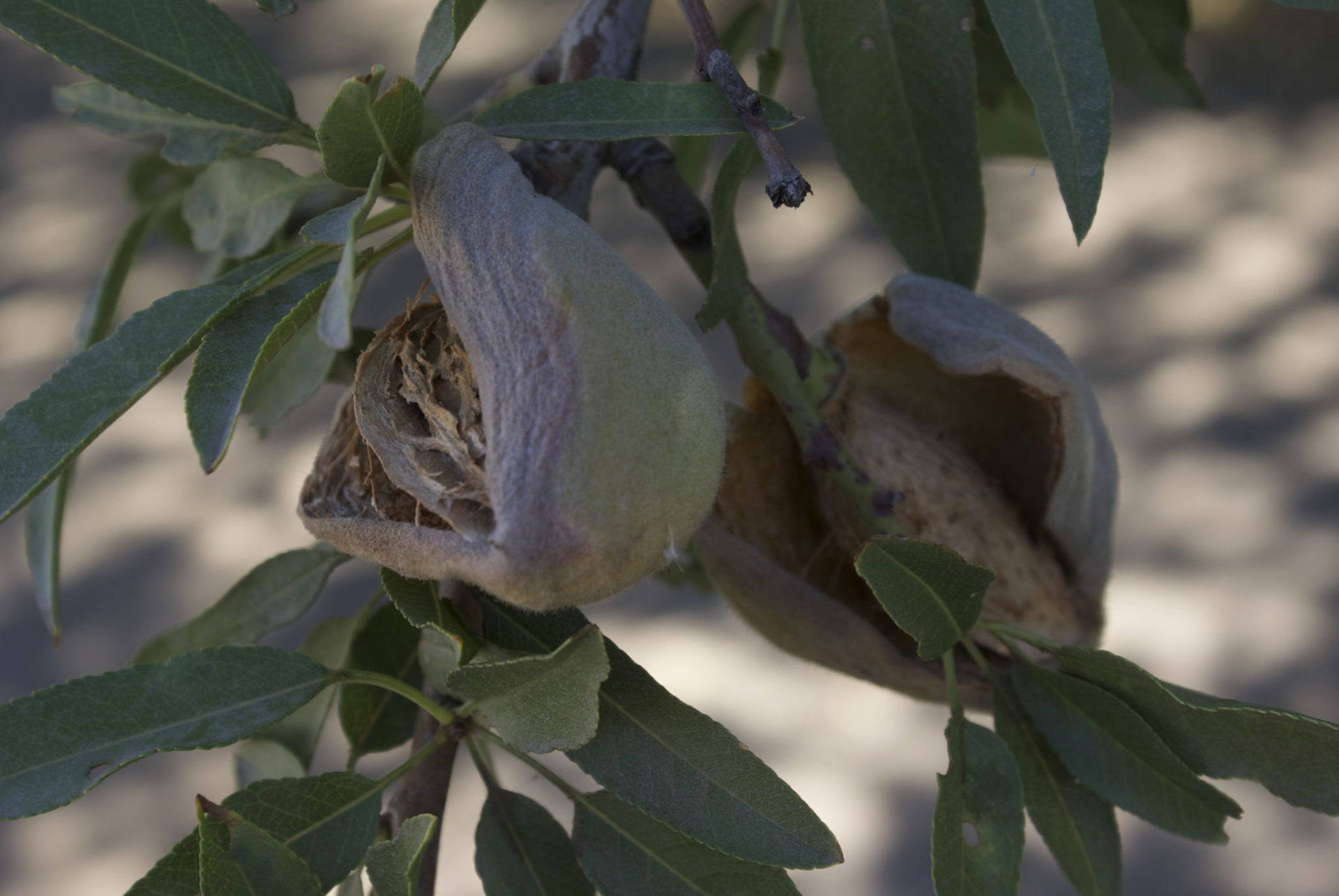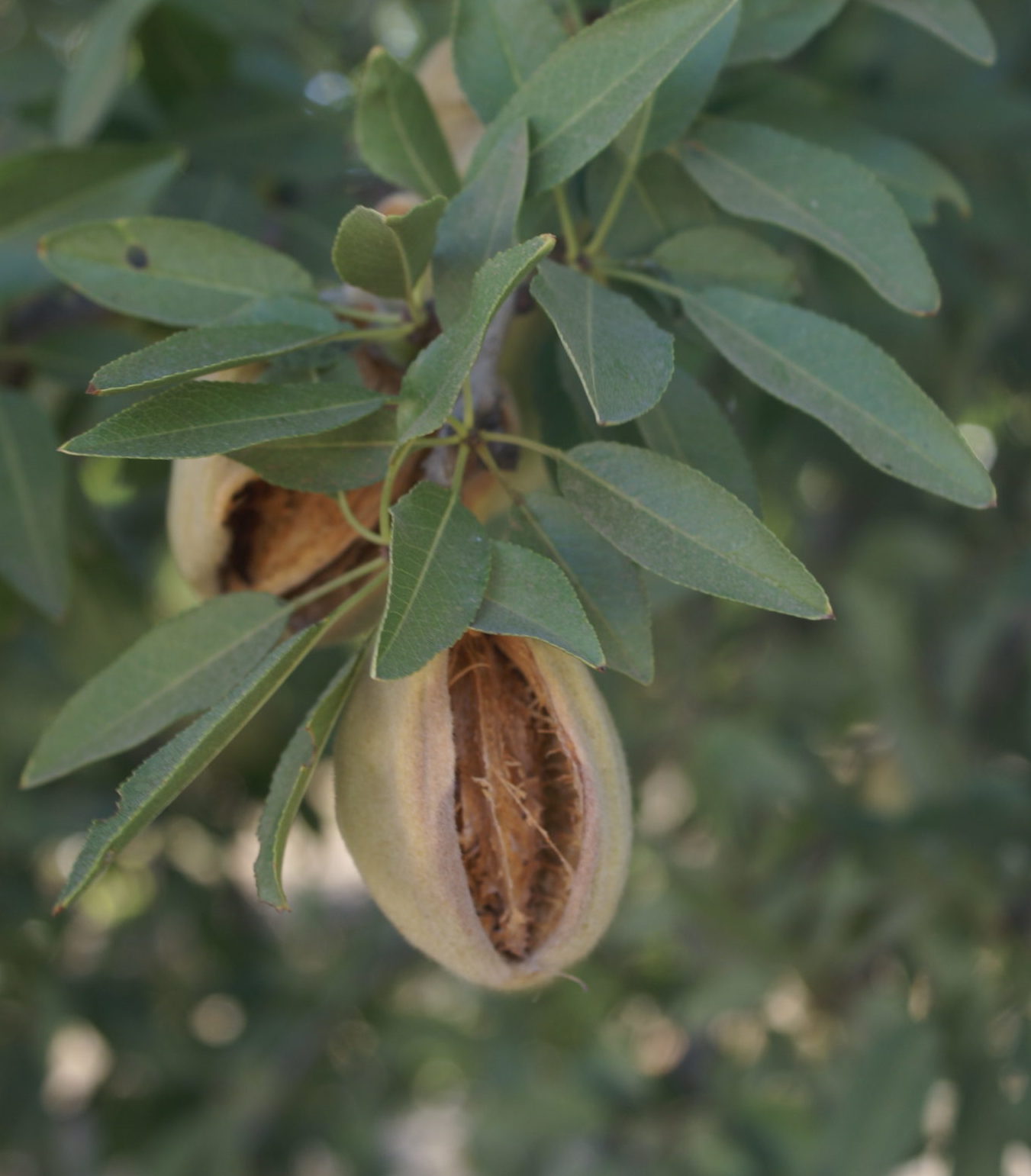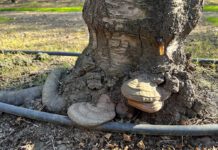
Hullsplit signals the approach of harvest and presents opportunities for growers to ensure a quality crop. A year’s worth of careful water and nutrition management, pest control and floor maintenance can be realized at hullsplit. Predicting the onset of hullsplit, identifying hullsplit, protecting the crop from navel orangeworm from hullsplit to harvest, managing hull rot, and planning for an early harvest are all important considerations in June.
Predicting Hullsplit
Predicting when hullsplit will occur in a specific orchard gives the grower or farm manager the ability to determine the earliest harvest date. Accurate prediction helps almond growers plan for logistics of harvest and late season orchard management. Timely harvest can mean a cleaner crop delivered to the market.
This critical stage of almond development typically begins mid to late June in western Kern County. Splitting of blank nuts, which typically make up about 3 to 5 percent of almonds, according to the Almond Board of California, will occur about a week ahead of hullsplit and serves as a ‘heads-up” for growers.
The Almond Board has developed a hullsplit prediction model using data from an eight-year study conducted in north, central and southern almond growing regions for many of the main cultivars. The hullsplit model is based on the assumption that the rate of fruit development from bloom to 1-percent hullsplit is highly dependent on early spring temperatures. The model predicts a date for almond hullsplit per location, based on input of a date of 1-percent full bloom and temperature readings during the first 90 days after bloom. The temperatures are collected by a specific CIMIS weather station designated by the user. ABC notes that the model will only work 90 days after bloom.
Initial split of the hull happens in the upper and outer portions of the canopy, mostly in the southwest corner of the tree. Once the hullsplits, it is vulnerable to hull rot and infestation by navel orangeworm. The Almond Board notes that the most effective time to spray for navel orangeworm is during its second flight and that often coincides with the initiation of hullsplit.
Navel Orangeworm Control
Navel orangeworm trapping early in the season can give a grower or pest control advisor an idea of the NOW pressure at hullsplit. Brad Higbee, research entomologist with Trece Inc., said using as many different types of trapping systems as possible will provide the best picture of the NOW pressure in an orchard. The single most attractive lure is a combination of a pheromone trap and PPO (phenyl propionate) lure placed in the orchard in the spring. At hullsplit, Higbee said, egg traps are not as sensitive, partially because the splitting hulls compete with the traps. Pheromone traps tell the real story in a conventional orchard. Populations are typically low during the initial part of hullsplit as it is between flights 1 and 2 and flight 2 is usually small, he added. In August, during the third flight, egg trap counts go up because populations are higher.
In orchards where mating disruption is not used, Higbee suggested monitoring for splits and making a NOW spray at the beginning of hullsplit, knowing that a second spray may be warranted. NOW populations can come on strong before harvest and there is no reason to be conservative with monitoring and control measures, Higbee said. ABC notes that high populations of NOW in an orchard may warrant a second insecticide application 2 to 3 weeks after initiation of hullsplit. Considerations for this action include varieties in the orchard, anticipated harvest dates and pheromone and egg trap counts.
The preferred hullsplit spray materials are Intrepidâ (methoxyfenozide ) and Altacorâ (chlorantraniliprole) according to UC IPM. NOW resistance issues have surfaced with pyrethroid use at hullsplit, plus these broad spectrum insecticides can negatively impact beneficial insect populations.
Knowing orchard history with regard to NOW pressure is useful. Proximity of an almond orchard to pistachios or orchards where winter sanitation was not done is another consideration.
Spray Timing
Spray timing is a critical aspect of control, said Franz Niederholzer, UCCE orchard systems advisor in Colusa, Sutter and Yuba counties. Once the suture of the hull opens, female NOW can find the nuts and move in to lay eggs. In four days, with normal summer temperatures, the eggs will hatch and larvae can move inside the hull and the damage begins. He advises growers to complete a spray application in an orchard in a week or less.
Early hullsplit starts in the upper canopy and may go unnoticed at eye level. That is why, Niederholzer said, starting spray applications earlier rather than later is always a good bet. The NOW population may not be high at hullsplit, he warned, but there are enough in the orchard to inflict damage and their numbers will grow through the summer.
Matching spray equipment to the tree will help achieve good coverage with the spray material. The material has to reach the top of the canopy. This is especially challenging especially where trees are mature and canopies are dense. Recommended ground speed under these conditions is 2 mph. Niederholzer said that aerial applications may be a consideration to shorten spray timing for the first hull split spray when most splitting nuts are in the tree tops. Aerial spraying delivers better spray coverage in the tree tops than lower in the canopy, just the opposite of ground spraying.
Managing Hull Rot
Beginning at hullsplit, there is approximately a one-month window for hull rot pathogens to infect almonds. Prevention of hull rot damage in an almond crop involves strategic irrigation and nutrition management. Hull rot infections are found in orchards with high rates of irrigation and fertilization. According to the Almond Board, managing water and fertilizer applications can reduce the incidence of hull rot by 60 to 90 percent. Irrigation strategies to induce moderate stress in trees can also produce a more uniform hullsplit and earlier harvest. The target period for producing moderate stress in trees is from the start of hullsplit through 90-percent hullsplit.
Almond Board funded research has shown that stressing almond trees at specific stages of production through managed deficit irrigation can reduce hull rot (see related story in this issue of West Coast Nut.) The target period for inducing water stress is from the start of hullsplit through 90-percent hullsplit—a period of about two weeks. Use of pressure chambers can give an accurate stress level reading, but irrigating at 50-percent of normal tree demand, using ET calculations, can also produce similar tree stress levels.
Achieving the desired stress level at the right time also depends on orchard conditions. Where soils are shallow, stress can be achieved at a faster pace. Under those conditions stress should be initiated when blanks begin to split. With deeper soils, it may take 20 to 30 days to reach mild to moderate stress. This is where use of a pressure chamber can assist in determining when the appropriate stress level is reached.

Aflatoxin and Timely Harvest
Due to the threat of crop damage posed by the third generation NOW flight, earliest possible harvest is recommended.
A 95- to 100-percent hullsplit at eye level is the optimum time for getting nuts off the trees. Early varieties are less likely to be NOW egg laying sites when they are on the ground. It is recommended that early maturing varieties such as Nonpareil, be shaken before a third generation NOW flight.
Another reason to determine hullsplit is to make applications to reduce aflatoxin contamination is orchards. Growers looking to apply AF36 Prevailâ have a window of 1 to 2 weeks in advance of hullsplit. AF 36, an atoxigenic Aspergillus mold, is carried on a sterilized sorghum seed and displaces existing toxigenic mold strains when applied to orchard floors. It is proved to be most effective when spread on moist soil in July. Maximum sporulation of AF36 during hullsplit is desired.















